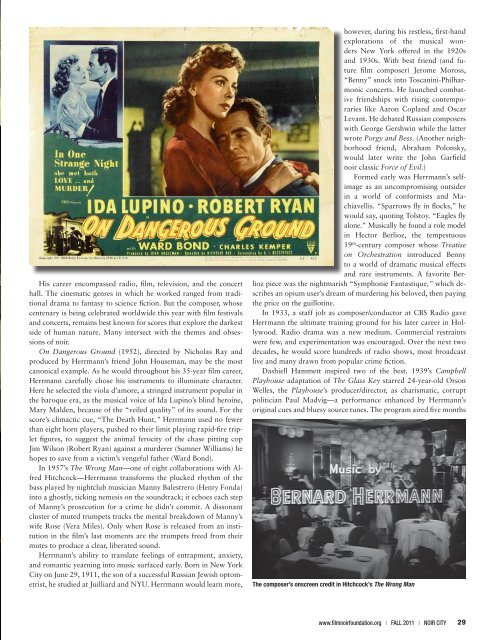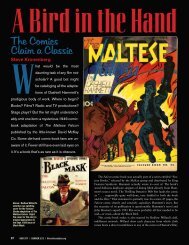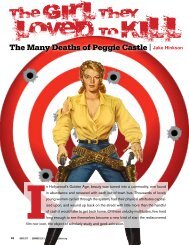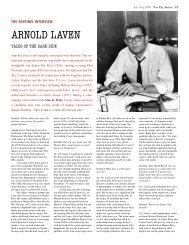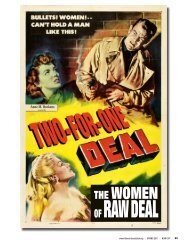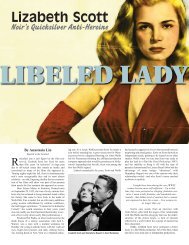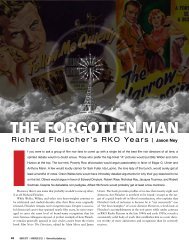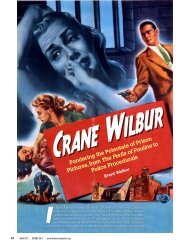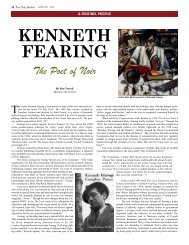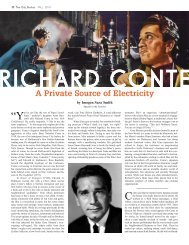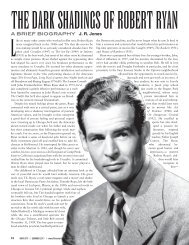BERNARD HERRMANN - Film Noir Foundation
BERNARD HERRMANN - Film Noir Foundation
BERNARD HERRMANN - Film Noir Foundation
Create successful ePaper yourself
Turn your PDF publications into a flip-book with our unique Google optimized e-Paper software.
His career encompassed radio, film, television, and the concert<br />
hall. The cinematic genres in which he worked ranged from traditional<br />
drama to fantasy to science fiction. But the composer, whose<br />
centenary is being celebrated worldwide this year with film festivals<br />
and concerts, remains best known for scores that explore the darkest<br />
side of human nature. Many intersect with the themes and obsessions<br />
of noir.<br />
On Dangerous Ground (1952), directed by Nicholas Ray and<br />
produced by Herrmann’s friend John Houseman, may be the most<br />
canonical example. As he would throughout his 35-year film career,<br />
Herrmann carefully chose his instruments to illuminate character.<br />
Here he selected the viola d’amore, a stringed instrument popular in<br />
the baroque era, as the musical voice of Ida Lupino’s blind heroine,<br />
Mary Malden, because of the “veiled quality” of its sound. For the<br />
score’s climactic cue, “The Death Hunt,” Herrmann used no fewer<br />
than eight horn players, pushed to their limit playing rapid-fire triplet<br />
figures, to suggest the animal ferocity of the chase pitting cop<br />
Jim Wilson (Robert Ryan) against a murderer (Sumner Williams) he<br />
hopes to save from a victim’s vengeful father (Ward Bond).<br />
In 1957’s The Wrong Man—one of eight collaborations with Alfred<br />
Hitchcock—Herrmann transforms the plucked rhythm of the<br />
bass played by nightclub musician Manny Balestrero (Henry Fonda)<br />
into a ghostly, ticking nemesis on the soundtrack; it echoes each step<br />
of Manny’s prosecution for a crime he didn’t commit. A dissonant<br />
cluster of muted trumpets tracks the mental breakdown of Manny’s<br />
wife Rose (Vera Miles). Only when Rose is released from an institution<br />
in the film’s last moments are the trumpets freed from their<br />
mutes to produce a clear, liberated sound.<br />
Herrmann’s ability to translate feelings of entrapment, anxiety,<br />
and romantic yearning into music surfaced early. Born in New York<br />
City on June 29, 1911, the son of a successful Russian Jewish optometrist,<br />
he studied at Juilliard and NYU. Herrmann would learn more,<br />
however, during his restless, first-hand<br />
explorations of the musical wonders<br />
New York offered in the 1920s<br />
and 1930s. With best friend (and future<br />
film composer) Jerome Moross,<br />
“Benny” snuck into Toscanini-Philharmonic<br />
concerts. He launched combative<br />
friendships with rising contemporaries<br />
like Aaron Copland and Oscar<br />
Levant. He debated Russian composers<br />
with George Gershwin while the latter<br />
wrote Porgy and Bess. (Another neighborhood<br />
friend, Abraham Polonsky,<br />
would later write the John Garfield<br />
noir classic Force of Evil.)<br />
Formed early was Herrmann’s selfimage<br />
as an uncompromising outsider<br />
in a world of conformists and Machiavellis.<br />
“Sparrows fly in flocks,” he<br />
would say, quoting Tolstoy. “Eagles fly<br />
alone.” Musically he found a role model<br />
in Hector Berlioz, the tempestuous<br />
19 th -century composer whose Treatise<br />
on Orchestration introduced Benny<br />
to a world of dramatic musical effects<br />
and rare instruments. A favorite Berlioz<br />
piece was the nightmarish “Symphonie Fantastique,” which describes<br />
an opium user’s dream of murdering his beloved, then paying<br />
the price on the guillotine.<br />
In 1933, a staff job as composer/conductor at CBS Radio gave<br />
Herrmann the ultimate training ground for his later career in Hollywood.<br />
Radio drama was a new medium. Commercial restraints<br />
were few, and experimentation was encouraged. Over the next two<br />
decades, he would score hundreds of radio shows, most broadcast<br />
live and many drawn from popular crime fiction.<br />
Dashiell Hammett inspired two of the best. 1939’s Campbell<br />
Playhouse adaptation of The Glass Key starred 24-year-old Orson<br />
Welles, the Playhouse’s producer/director, as charismatic, corrupt<br />
politician Paul Madvig—a performance enhanced by Herrmann’s<br />
original cues and bluesy source tunes. The program aired five months<br />
The composer’s onscreen credit in Hitchcock’s The Wrong Man<br />
www.filmnoirfoundation.org I FALL 2011 I NOIR CITY 29


